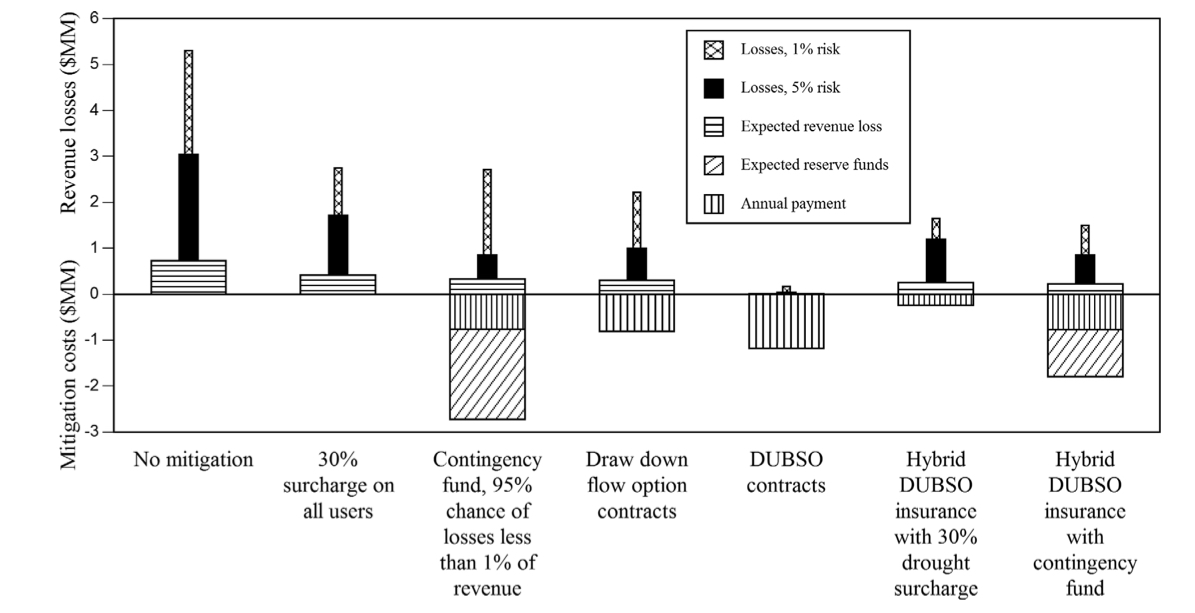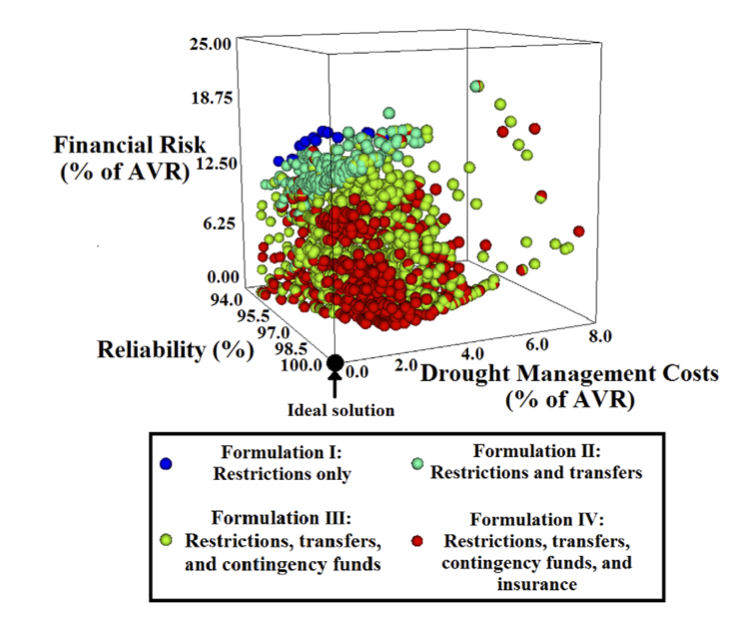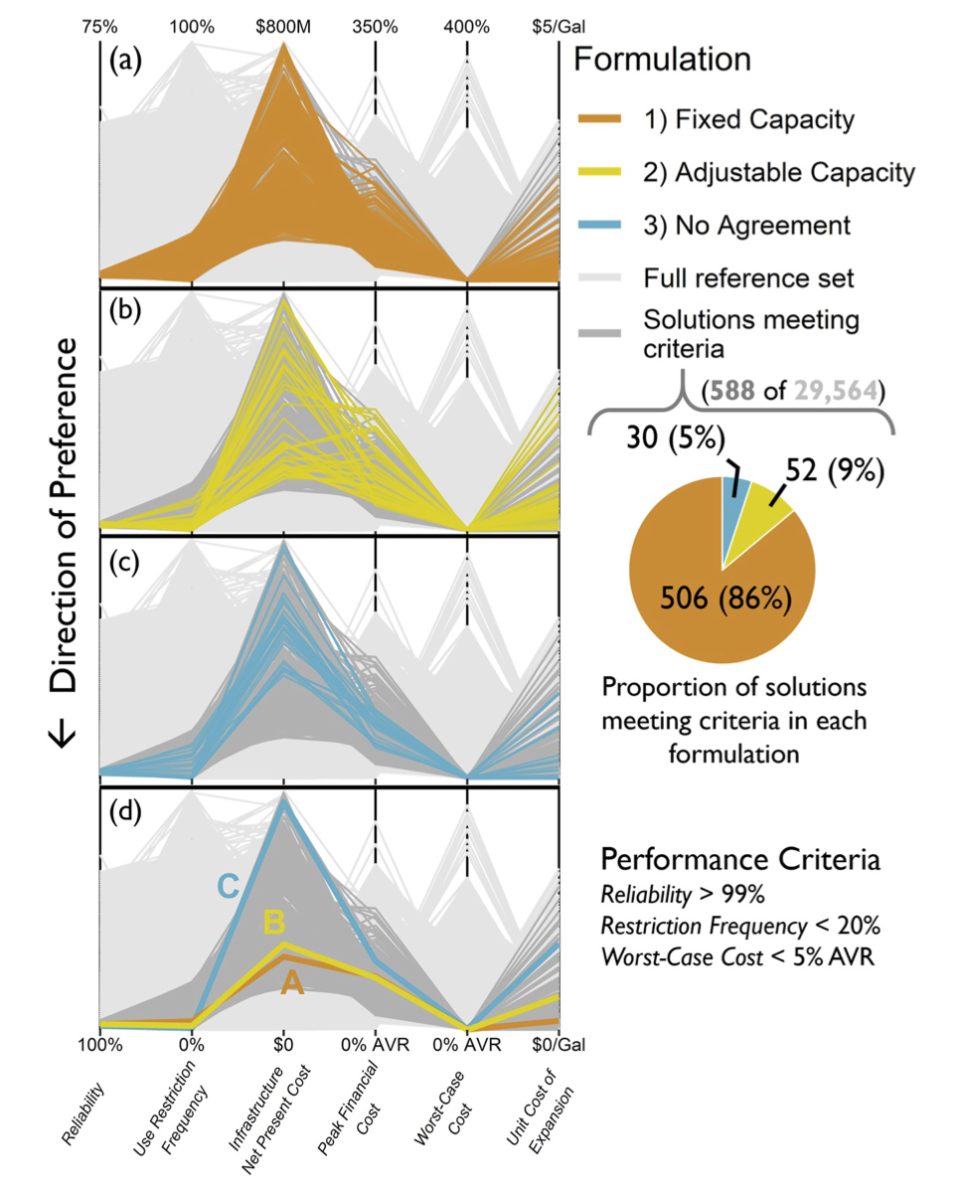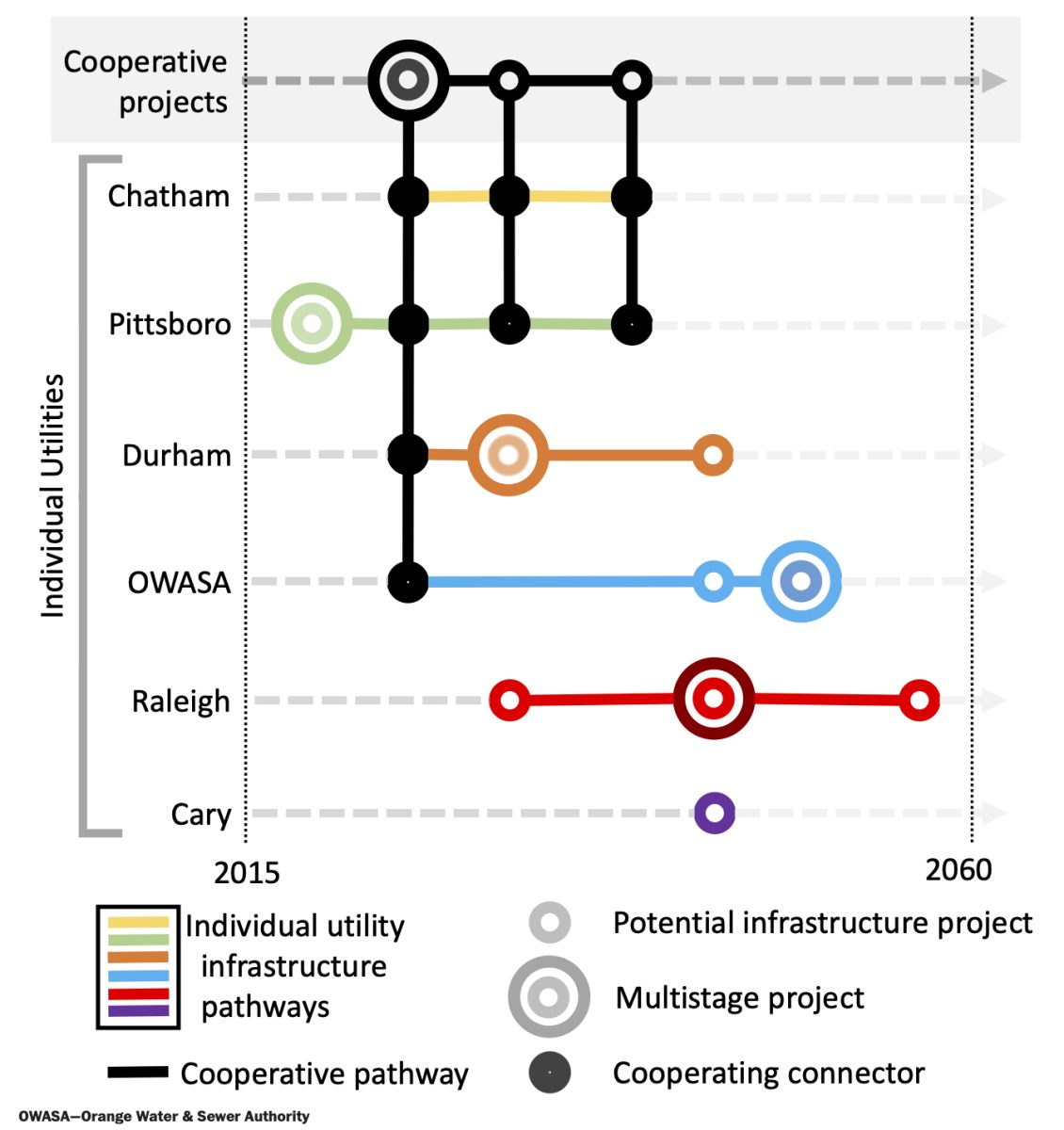Center on Financial Risk in Environmental Systems: Research Triangle (North Carolina)
Research Triangle
Project 1 Title:
Managing Water Utility Financial Risks through Third-Party Index Insurance Contracts
Summary:
As developing new water supply capacity has become increasingly expensive and difficult to permit (i.e., regulatory approval), water utilities have become more reliant on temporary demand management programs, such as outdoor water use restrictions, for ensuring reliability during drought. However, a significant fraction of water utility income is often derived from the volumetric sale of water, and such restrictions can lead to substantial revenue losses. Given that many utilities set prices at levels commensurate with recovering costs, these unexpected revenue losses can leave them financially vulnerable to budgetary shortfalls. This work explores approaches for mitigating drought-related revenue losses through the use of third-party financial insurance contracts based on streamflow indices.

Comparison of the risk of revenue losses and annual costs (as well as unspent reserve funds) across various mitigation approaches, including two different types of third-party index-based financial contracts (Drawdown flow options and DUBSO contracts)
Description:
Two different types of index-based financial contracts are developed, and their efficacy is compared against two more traditional forms of financial hedging used by water utilities: drought surcharges and contingency funds (i.e., reserves). Strategies involving each of these approaches, as well as their use in combination, are applied under conditions facing the water utility serving Durham, North Carolina. A multi-reservoir model provides information on the scale and timing of droughts, and the financial effects of these events are simulated using detailed data derived from utility billing records. Results suggest that third-party index insurance contracts, either independently or in combination with more traditional hedging tools, can provide an effective means of reducing a utility’s financial vulnerability to drought.
Related Publication:
[superscripts denoting graduate students (M = masters; D = doctoral) and Post-doctoral Researchers (P) or Researchers (R)) working in CoFiRES]
Zeff, H.B.M and G. W. Characklis (2013). “Managing Water Utility Financial Risks through Third-Party Index Insurance Contracts,” Water Resources Research, 49, doi:10.1002/wrcr.20364.
Project 2 Title:
Navigating Financial and Supply Reliability Tradeoffs in Regional Drought Portfolios
Summary:
Rising development costs and growing concerns over environmental impacts have led many communities to explore more diversified water management strategies. These ‘‘portfolio’’-style approaches integrate existing supply infrastructure with other options such as conservation measures or water transfers from other utilities. Diversified water supply portfolios have been shown to reduce the capacity and costs of meeting demand, while also providing greater adaptability to changing hydrologic conditions. However, this additional flexibility can also cause unexpected reductions in revenue (from conservation) or increased costs (from transfers). The resulting financial instability can act as a substantial disincentive to utilities seeking to implement more innovative water management techniques.

Three-dimensional tradeoffs between reliability, drought management costs, and financial risk for each of four management scenarios, including (I) outdoor water restrictions only; (II) Restrictions and water transfers from other utilities; (III) Restrictions, transfers and a contingency (reserve) fund, and (IV) Restrictions, transfers, contingency fund and index insurance. The inclusion of financial mitigation tools in III and IV introduces a tradeoff between financial risk and drought management costs that allow for the design of portfolios with high-reliability and low-financial risk.
Description:
This study seeks to design water supply portfolios that employ financial tools (e.g., contingency funds and index insurance) to reduce fluctuations in revenues and costs, allowing these strategies to achieve improved water supply reliability without sacrificing financial stability. This analysis is applied to the development of coordinated regional supply portfolios in the ‘Research Triangle region of North Carolina, an area comprising four rapidly growing municipalities. The actions of each independent utility become interconnected when shared infrastructure is utilized to enable inter-utility transfers, requiring the evaluation of regional tradeoffs in up to five performance and financial objectives. Diversified strategies introduce significant tradeoffs between achieving supply reliability goals and introducing burdensome variability in annual revenues and/or costs. Financial mitigation tools can mitigate the impacts of this variability, allowing for an alternative suite of improved solutions. This analysis provides a general template for utilities seeking to navigate the tradeoffs associated with more flexible, portfolio-style management approaches.
Related Publication:
[superscripts denoting graduate students (M = masters; D = doctoral) and Post-doctoral Researchers (P) or Researchers (R)) working in CoFiRES]
Zeff, H. B., Kasprzyk, J. R., Herman, J. D., Reed, P. M. and G. W. Characklis (2014). “Navigating Financial and Supply Reliability Tradeoffs in Regional Drought Portfolios,” Water Resources Research, 50, doi:10.1002/2013WR015126.
Project 3 Title:
Impact of inter-utility agreements on cooperative regional water infrastructure investment and management pathways
Summary:
Urban water utilities facing rising demands and limited supply expansion options increasingly partner with neighboring utilities to develop and operate shared infrastructure. Inter-utility agreements can reduce costs via economies of scale and help limit environmental impacts, as substitutes for independent investments in large capital projects. However, unexpected shifts in demand growth or water availability, deviating from projections underpinning cooperative agreements, can introduce both supply and financial risk to utility partners. Risks may also be compounded by asymmetric growth in demand across partners or the inflexibility of the agreement structure itself to adapt to changing conditions of supply and demand.

Parallel-axis plots of the Pareto-approximate reference set of solutions (light gray), compared to solutions meeting utility performance criteria (dark gray). Solution performance is shown across management objectives (from left to right). Each colored line represents objective results for a single solution. Solution performance is better if its line is closer to the bottom of the plot across each objective. Panels (a, b, c) compare the full reference set of solutions to those meeting criteria by formulation (color); panel (d) identifies three representative high-performance solutions meeting utility criteria, used for detailed comparison in subsequent results. Inset pie chart and text descriptions detail the proportion of solutions meeting utility criteria under each inter-utility agreement formulation.
Description:
This work explores the viability of both fixed and adjustable capacity inter-utility cooperative agreements to mitigate regional water supply risk and financial risk for utilities that vary in size, growth expectations, and independent infrastructure expansion options. Agreements formalized for a shared regional water treatment plant are found to significantly improve regional supply reliability and financial outcomes, despite highly correlated weather and climate across neighboring supply systems (e.g., concurrent drought events). Regional improvements in performance, however, mask tradeoffs among individual agreement partners. Adjustable treatment capacity allocations add flexibility to inter-utility agreements but can compound financial risk to each utility as a function of the decision-making of the other partners. Often the sensitivity to partners’ decision-making under an adjustable agreement degrades financial performance, relative to agreements with fixed capacities allocated to each partner. Our results demonstrate the significant benefits cooperative agreements offer, providing a template to aid decision-makers in the development of water supply partnerships.
Related Publication:
[superscripts denoting graduate students (M = masters; D = doctoral) and Post-doctoral Researchers (P) or Researchers (R)) working in CoFiRES]
Gorelick, D. E.D, Gold, D. F., Reed, P. M. and G. W. Characklis (2022), “Impact of inter-utility agreements on cooperative regional water infrastructure investment and management pathways,” Water Resources Research, 58, e2021WR030700, https://doi.org/10.1029/2021WR030700
Project 4 Title:
Designing water utility cooperative agreements: Lessons learned in North Carolina
Summary:
Developing infrastructure projects for water and wastewater utilities can take years or even decades. After environmental reviews, master plan updates, and suitability analyses are complete, short-listed options may still face hurdles in construction, financing, implementation, and operation. As urban areas continue to grow and opportunities for water supply expansion shrink, the challenges of keeping up with rising demand increase. Under these circumstances, water managers must find more innovative ways to ensure affordable, reliable water service over the long term.

Schematic includes regional cooperative pathways (top row) over the planning horizon. Vertical (black) lines indicate potential project connections between cooperating utilities. Circles indicate estimated year in which projects become available to implement (e.g., after clearing environmental permitting processes, board approval, and so on).
Description:
Continued growth and service area expansion mean that municipalities and utilities are increasingly pressed to share water resources. Successful resource management among multiple water systems can require substantial political, legal, and institutional cooperation, adding to already complicated long-term planning for each partnering utility. However, within the constraints of cooperation come practical benefits. Cooperative infrastructure development can reduce capital and operating costs through economies of scale, make more efficient use of existing resources, and build physical redundancies for emergency conditions (i.e., additional water treatment or supply sources). As a result, inter-utility agreements are becoming more common in the United States and worldwide. Cooperation among water utilities expands opportunities to provide an affordable, reliable water supply, both now and in the long term. Computational modeling of utility partnerships can explore the potential benefits (and pitfalls) of cooperative infrastructure development. Analysis of agreements for shared treatment plant development in North Carolina provides a framework for the design and evaluation of cooperation in other utility contexts.
Related Publication:
[superscripts denoting graduate students (M = masters; D = doctoral) and Post-doctoral Researchers (P) or Researchers (R)) working in CoFiRES]
Gorelick, D. E.P, Gold, D. F., Reed, P. M. and G. W. Characklis (2023). “Designing water utility cooperative agreements: Lessons learned in North Carolina,” Journal of the American Water Works Association, 115(1), pp. 32-40, doi.org/10.1002/awwa.2034
Collaborators:
Dr. Pat Reed, Cornell
Dr. Jon Herman, University of California, Davis
Jeff Hughes, Environmental Finance Center, UNC
Dr. Joe Kasprzyk, University of Colorado, Boulder
Dr. Andy Yates, Economics, UNC
Other Publications from related projects:
[superscripts denoting graduate students (M = masters; D = doctoral) and Post-doctoral Researchers (P) or Researchers (R)) working in CoFiRES]
Gold, D.F., Reed, P.M., Gorelick, D.E.D, and G. W. Characklis (2022). “Power and Pathways: Exploring robustness, cooperative stability and power relationships in regional infrastructure investment and water supply management portfolio pathways, Earth’s Future, 10, e2021EF002472, https://doi.org/10.1029/2021EF002472
Trindade, B., Reed, P.M., Gold, D.F., Zeff, H.B.P and G. W. Characklis (2020). Water Pathways: An open-source stochastic simulation framework for water supply portfolio management and infrastructure investments, Environmental Modelling and Software, 104772, https://doi.org/10.1016/j.envsoft.2020.104772.
Zeff, H.B.P, Characklis, G.W. and W.N. Thurman (2020). “How do price surcharges impact water utility incentives to pursue alternative supplies during drought,” Journal of Water Resources Planning and Management, 146(6), doi.org/10.1061/(ASCE)WR.1943-5452.0001228.
Gorelick, D.E.D, Lin, L., Zeff, H.B.P, Kim, Y., Vose, J. M., Coulston, J. W., Wear, D. N., Band, L. E., Reed, P. M. and G. W. Characklis (2019). “Accounting for adaptive water supply management when quantifying climate and landcover change vulnerability,” Water Resources Research, 56, e2019WR025614, doi.org/10.1029/2019WR025614
Gold, D.F., Reed, P. M., Trindade, B.C. and G.W. Characklis (2019). “Conflicts in Coalitions: Navigating multi-city robustness conflicts to discover cooperative safe operating spaces for regional water supply portfolios,” Water Resources Research 55, pp. 9024–9050, doi.org/10.1029/2019WR025462
Trindade, B., Reed, P.M. and G. W. Characklis (2019). “Deeply Uncertain Pathways: Integrated Multi-City Regional Water Supply Infrastructure Investment and Portfolio Management,” Advances in Water Resources, 134, 103442, doi.org/10.1016/j.advwatres.2019.103442
Gorelick, D.E.D, Zeff, H.B.P, Hughes, J., Eskaf, S. and G.W. Characklis (2019). “Benefits and tradeoffs of cooperation: exploring the relative merits of treatment and capacity sharing agreements between water utilities,” Journal of the American Water Works Association, 111(9), pp 26-40. doi.org/10.1002/awwa.1359
Gorelick, D.E.M, Zeff, H.B.P, Characklis, G.W. and P.M. Reed (2018). “Integrating raw water transfers into an Eastern United States management context,” Journal of Water Resources Planning and Management, 144 (9), doi.org/10.1061/(ASCE)WR.1943-5452.0000966.
Mozenter, Z.D., Yates, A.J., Schnier, K.A., Hughes, J.A. and G.W. Characklis (2018). “Understanding Water Utility Attitudes Toward Water Transfers and Risk: Survey Results,” Journal of Water Resources Planning and Management, doi: 10.1061/(ASCE)WR.1943-5452.0000895.
Trindade, B.C., Reed, P.M., Herman, J.D., Zeff, H.B. and G.W. Characklis (2017). “Reducing Regional Drought Vulnerabilities and Multi-City Robustness Conflicts Using many-Objective Optimization Under Deep Uncertainty,” Advances in Water Resources, 104, pp. 195-209, doi:10.1016/jadvwatres.2017.03.023.
Zeff, H.B., Herman, J.D., Reed, P.M. and G.W. Characklis (2016). “Cooperative drought adaptation: Integrating infrastructure development, conservation, and water transfers into adaptive policy pathways,” Water Resources Research, 52, doi:10.1002/2016WR018771.
Herman, J.D., Zeff, H.B., Lamontagne, J.R., Reed, P.M. and G. W. Characklis (2016). “Synthetic Drought Scenario Generation to Support Bottom-Up Water Supply Vulnerability Assessments,” Journal of Water Resources Planning and Management, doi:10.1061/(ASCE)WR.1943-5452.0000701.
Herman, J.D., Reed, P.M., Zeff, H.B. and G. W. Characklis (2015). “How Should Robustness be Defined for Water Systems Planning Under Change,” Journal of Water Resources Planning and Management, doi:10.1061/(ASCE)WR.1943-5452.0000509, 04015012.
Herman, J.D., Zeff, H.B., Reed, P.M. and G.W. Characklis (2014). “Beyond Optimality: Multi-Stakeholder Robustness Tradeoffs for Regional Water Portfolio Planning Under Uncertainty,” Water Resources Research, doi:10.1002/2014WR015338.
Caldwell, C. and G.W. Characklis (2014). “Impact of Contract Structure and Risk Aversion on Inter-utility Water Transfer Agreements,” Journal of Water Resources Planning and Management, 140(1), doi: 10.1061/(ASCE)WR.1943-5452.
Kirsch, B.R.D, Characklis, G.W. and H.B. ZeffM (2013). “Evaluating the Impact of Alternative Hydro-climate Scenarios on Transfer Agreements: A Practical Improvement for Generating Synthetic Streamflows,” Journal of Water Resources Planning and Management, 139(4), pp. 396-406.
Palmer, R.N.M and G.W. Characklis (2009). “Reducing the Costs of Meeting Regional Water Demand through Risk-based Transfer Agreements,” Journal of Environmental Management, 90, pp. 1703-1714.
Funding Support:
National Science Foundation: Water Sustainability and Climate (WSC) program, award no. EAR-1360442
National Oceanic and Atmospheric Administration (NOAA), Sectoral Applications Research Program (SARP), award no. NA11OAR4310144
